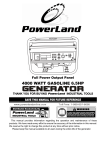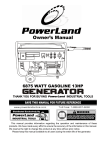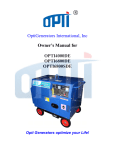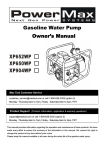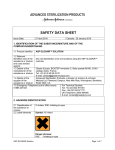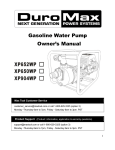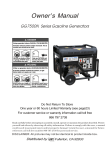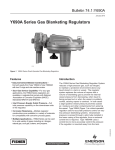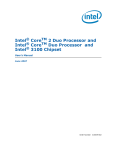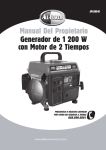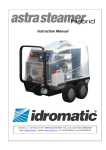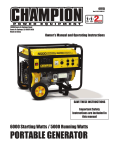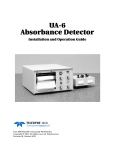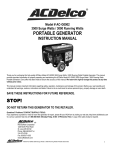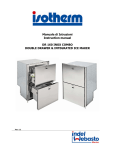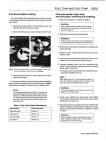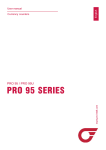Download to user manual
Transcript
Gasoline Engine Owner’s Manual This manual provides information regarding the operation and maintenance of these products. We have made every effort to ensure the accuracy of the information in this manual. We reserve the right to change this product at any time without prior notice. Please keep this manual available to all users during the entire life of the Gasoline Engine. CONTENTS SAFETY PRECAUTIONS ............................................................................................................................................ 2 PARTS DESCRIPTION ................................................................................................................................................ 3 BATTERY CONNECTION (electric-start type) ......................................................................................................... 4 PRE-OPERATE INSPECTION.................................................................................................................................... 4 ENGINE OIL........................................................................................................................................................... 4 FUEL AND FUEL TANK ....................................................................................................................................... 6 STARTING THE ENGINE ............................................................................................................................................ 8 RUNNING THE ENGINE.............................................................................................................................................. 9 ENGINE OIL ALARM ............................................................................................................................................ 9 OPERATING ON HIGHLANDS........................................................................................................................... 9 STOP............................................................................................................................................................................. 10 EXHAUST CONTROL SYSTEM............................................................................................................................... 10 MAINTENANCE........................................................................................................................................................... 11 MAINTENANCE SCHEDULE ............................................................................................................................ 11 REPLACEMENT OF ENGINE OIL ................................................................................................................... 12 SERVICE OF AIR CLEANER ............................................................................................................................ 12 WASHING OF DEPOSIT CUP .......................................................................................................................... 14 SPARK PLUG ...................................................................................................................................................... 14 CARBURETOR IDLING ADJUSTMENT.......................................................................................................... 15 TRANSPORT, STORAGE AND REMOVAL FROM STORAGE .......................................................................... 15 TRANSPORT ....................................................................................................................................................... 15 STORAGE ............................................................................................................................................................ 15 REMOVAL FROM STORAGE........................................................................................................................... 16 SERVICE ITEM.................................................................................................................................................... 16 SPECIFCAIONS .......................................................................................................................................................... 17 TROUBLESHOOTING................................................................................................................................................ 18 I. START ENGINE DIFFICULTLY..................................................................................................................... 18 II. LOW GASOLINE ENGINE POWER OUTPUT........................................................................................... 19 III. GASOLINE ENGINE CANNOT RUN SMOOTHLY .................................................................................. 20 IV. STOP SUDDENLY WHEN RUNNING ....................................................................................................... 20 V. GASOLINE ENGINE IS EXCEESIVELY HOT ........................................................................................... 21 VI. THERE EXISTS ABNORMAL NOISE WHEN ENGINE RUNNING....................................................... 21 WIRING DIAGRAM ..................................................................................................................................................... 23 EXPLODED VIEW AND PARTS LIST(6.5HP)........................................................................................................ 25 EXPLODED VIEW AND PARTS LIST(13HP/16HP).............................................................................................. 27 1 SAFETY PRECAUTIONS WARNING: Before operating the engine, be sure to read and familiar with the manual carefully, otherwise personal injury or equipment damage may produce. Please pay special attention to the following: 1. Running the engine in a well-ventilated place, keep it at least one meter away from building walls or other equipments, keep away from inflammables such as gasoline, matches and so on to avoid possibility of fire. 2. Keep the engine out of reach of children and pets to avoid accidents. 3. Operator of engine has been specially trained. 4. Refuel in a well-ventilated area with the engine stopped, and in places refueling or storing gasoline, no smoking and any flames or sparks. 5. Refuel the fuel tank not too full so as to avoid fuel’s spilling out. If there is spilled fuel around, be sure to clean it thoroughly before starting. 6. Locate the engine on a level-working platform to avoid fuel’s spilling out. 7. Maker sure the fuel filler cap is tightened securely. 8. The exhaust muffler is very hot during running the engine even after the engine stops. Never touch it, or you may get burns. Transport or store the engine with it cooling down entirely. 2 PARTS DESCRIPTION The main parts of engine are located as follows 3 BATTERY CONNECTION (electric-start type) In the case that the specifications of the battery are 12V and more than 18A.h connect its positive lead to the electromagnetic coil while connect its negative lead to engine mount strew, base screw or any place capable of grounding with the engine well. Make sure the battery leads are connected tightly and no corrosion is found. If any, eliminate it. WARNING: ● The battery may give off explosive gas; keep sparks, flames and cigarettes away. Charge or use it in an area with good ventilation. ● The battery contains sylphlike acid (electrolyte). Contact with skin or eyes may cause severe burns. Wear protective clothing and a face shield. If electrolyte gets in your skin, flush with water; if gets in your eyes, flush with water for at least 15 minutes and call a physician at once. ● Electrolyte is poisonous. If swallowed, drink large quantities of water or milk, and follow with milk of magnesia or vegetable oil and oil a physician. ● Keep out of reach of children. CAUTION: ● Do not add tap water to the battery instead of distilled water, or the battery life will be short-need. ● Do not add distilled water over electrolyte upper level mark, or electrolyte will spill out to corrupt the engine parts. If so, be sure to wash them away with water. ● Make sure not to connect the battery leads in reverse or-deer, or short-circuit or breaker’s cutting may result. PRE-OPERATE INSPECTION ENGINE OIL CAUTION: ● Engine oil is key factor in deciding the engine’s performance. Do not apply engine oil with additives or 2-stroke gasoline oil, as they haven’t enough lubrication, which may shorten the en-gene’s service life. ● Check the engine with it stopped on a level ground. Engine oil recommended: SAE10W-30 As viscosity varies with regions and temperatures, so the lubricant has to be 4 selected in accordance with our recommendation. Check 1. 2. 3. 4. 5. Ensure that the engine is stopped on a level ground. Remove the dipstick and clean it. Reinsert the dipstick into the oil filler without screwing it, and check oil level. If the oil level is too low, add the recommended engine oil up to the oil filler neck. Reinstall the dipstick. CAUTION: Run with insufficient engine oil may damage the engine severely. OIL IN THE REDUCTION GEAR BOX (only for the model equipped with it) 1/2 Reduction gear with an auto-centrifugal clutch Brand of the box oil is the same as that of engine oil. Oil capacity: 0.3liters for 173F and 177F and 182F and 188F, 0.5liters for 168F and 168F-II. Check the oil lever in the following order. 1. Remove the dipstick and clean it. 2. Reinsert the dipstick without screwing it in, and then check oil level . 3. If the oil level is too low, add the recommended engine oil until it arrives the upper level mark. 4. Reinstall the dipstick. AIR CLEANER I. Double-core type Dismantle the air cleaner housing and check its filter element, make sure it clean and intact, otherwise clean or replace it. II. Dust-collecting type 1. Dismantle the dust-collecting hood and check the filter element of the air cleaner; make sure it is clean and intact, otherwise clean or replace. 2. Check whether there is any dust or dirt inside the dust-collecting hood, if any, clears away. III. Single-core type Dismantle the air cleaner housing and check its filter element, make sure it is clean and intact, otherwise clean or replace. 5 IV. Oil-bath type 1. Dismantle the air cleaner housing and check its core, make sure it is clean and intact, otherwise clean or replace. 2. Check oil level and oil quality. If the oil level is too low, add the recommended engine oil up to oil level mark. CAUTION: Never run the engine without an air cleaner, or severe wear of the engine may result. FUEL AND FUEL TANK Fuel To ensure that the engine runs smoothly use only FRESH, UNLEADED GAS WITH AN OCTANE RATING OF 87 OR HIGHER. Using unleaded gasoline will decrease the possibility of producing car boll deposit and will prolong the engine’s service life. Never apply used or polluted gasoline or a mixture of gasoline with engine oil. Make sure the fuel is free of dirt and water. Gasoline Containing Alcohol If you decide to use a gasoline containing alcohol (fuel blend), be sure its octane rating is at least as high as that recommended by the company. There are two types of“gasohol”. One contains ethanol, and the other contains methanol. Neither gasoline containing more than 10% ethanol nor 5% methanol is allowed to be used. If methanol content in the fuel blend exceeds 5%, it may bring bad effect on the engine performance, besides, it may damage metals, rubber and plastic parts. CAUTION: Handle fuel with care because it change plastic and painted surface. It is normal when you hear occasionally light spark knock or pinking with the engine running under heavy load. If “spark knock” or “pinking” occurs at a steady speed under normal load, change brand of gasoline; if Such phenomena still happen, consult your dealer for help, otherwise the engine may be damaged. Fuel Tank Fuel tank capacity: 3.6liters for 168F and 168F-II , 6.5liters for 173F ,177F, 182F , 188F and 188F. 6 Check 1. Remove the fuel filler cap and check fuel level. 2. If the fuel level is too low, refuel the tank. Remember adding fuel not over the fuel filler shoulder. WARNING: ● Gasoline is extremely flammable and is explosive under certain conditions. Refueling in a well-ventilation area with the engine stopped. Do not smoke and smoke and allow flames or sparks in the area where gasoline is stored or where the fuel tank is refueled. ● Do not overfill the tank (there should be no fuel in the filler neck). After refueling, make sure the fuel filler cap is set back securely. ● Be careful not to spill fuel when refueling. Spilled fuel or fuel vapor may ignite. If any fuel is spilled, make sure the area is dry before starting the engine. ● Avoid repeated or prolonged contact with skin or breathing of fuel vapor. Keep out of reach of children. 7 STARTING THE ENGINE 1. Push the fuel cock to“ON”. 2. Push the choke lever to “CLOSE”. NOTE: if the engine is hot, closing the choke is unnecessary. 3. Move left the throttle lever a little. 4. Start the engine as follows: a) Hand-operated kick-starter Push the engine switch to“ON”. Pull slightly the starting rope handle up until feeling anti-action, and then make a rapid pull. CAUTION: Releasing the handle suddenly may make it hitting the engine. Release the handle slowly conforming to its recoiling force. b) Electric starter Push the engine switch to “START”and remain there until the engine starts. Once the engine starts, reset the engine switch to “ON”. CAUTION: Use the engine switch not more than 5 minutes each time to avoid damage of the engine. Try once more 10 minutes later after last attempt failures. 8 RUNNING THE ENGINE 1. Preheat the engine and push back the choke lever to “OPEN”. 2. Set the throttle lever in proper position to ensure the engine runs at required velocity. ENGINE OIL ALARM The engine oil alarm is designed to function when the engine oil in the crankcase is insufficient. Lack of engine oil may damage the engine. Oil may damage the engine. Once oil level in the crankcase is too low, the engine oil alarm will stall the engine automatically to make it free of damage while the engine switch is still at “ON”. CAUTION: If cannot restart the engine, check the engine oil level first before go to other check items. BREAKER (Electric-start type) The breaker will cut off automatically to protect the charging circuit of the battery in the case that short circuit or incorrect connection of the battery poles occurs. The green indicator in the breaker will jump out with the circuit cutting off. After finding troubles and troubleshooting, depress the breaker button to tune the breaker on. OPERATING ON HIGHLANDS On highlands, the standard mixture ratio is relatively too big so the engine performance may be impaired while the fuel consumption may increase, besides, too big mixture ratio will pollute the spark plug to result in starting the engine difficultly. This problem can be solved by amending the carburetor technological status. If always using on highlands with a height above sea level of 1800 meters, ask your dealer for doing the job. 9 CAUTION: Amended engine applicable to highlands may be damaged seriously in area below altitude of 1800 meters for overheating, because its mixture ratio is too small for operation in low altitude area. In the case, ask your dealer to recover the engine to its normal technical status. STOP In emergency, push the engine switch to “OFF” to stall the engine; to stop it in normal, do as follows: 1. Push right the throttle lever to the bottom. 2. Push the engine switch to “OFF”. 3. Set the fuel cock to “OFF”. CAUTION: Sudden stopping at high speed under heavy load is forbidden, otherwise damage will result. EXHAUST CONTROL SYSTEM With the engine running, carbon monoxide, oxide of nitrogen and hydrocarbon will produce, and in certain conditions, oxide of nitrogen and hydrocarbon will react chemically each other to make smoke while carbon monoxide is toxic, so exhaust control of them is very important. The company decreases the exhaust emissions by introducing poor-fuel carburetors and other devices into the engine to solve the problem. To keep the exhaust of your engine with in the standard exhaust emission, pay attention to the following: 1. Maintenance Maintain the engine periodically in accordance with the maintenance schedule in the manual. The maintenance schedule is made out on the base of normal use in normal conditions, if using under heavy load, dusty or wet circumstances or in high temperature, service of the engine should be done more 10 often. 2. Replacement of Parts We recommend that you should choose such parts which are manufactured by the company or equivalent to these in quality as replacement ones. Replacement without so high quality as the original may impair the exhaust the exhaust control system in effectiveness. 3. Modifying Modifying the exhaust control system may make actual exhaust emissions exceeding statutory limit values. Illegal modification as such: a) Dismantle or modify any part of air intake or exhaust system. b) Modify or take off speed-adjusting connection device or speed adjustment device to result in the engine’s running beyond the set parameters. 4. Problems Affecting Exhaust Emissions a) Difficult starting or difficult stopping. b) Unstable idling. c) Give off black smoke or consume too much fuel. d) Poor ignition sparks or sparks returned. Once you find any of above problems, contact your dealer for help. MAINTENANCE MAINTENANCE SCHEDULE Each time Frequency Item Engine oil Reduction oil Air cleaner gear Deposit cup Spark plug Spark eliminator Idling Valve clearance Fuel tank & fuel filter Fuel supply line Oil level check Replace Oil level check Replace Check Clean Replace Clean Clean, adjust Replace Clean Check-adjust Check-adjust First month 12 hrs Each Every or season or month 50 hrs 100 hrs √ √ √ √ √ √ √ √① √②* √** √ √ √ √ √② √② Clean Check 6 Each or year or 300 hrs √② Every two years (do a replacement if necessary) CAUTION: Use only parts from the company or equivalents in quality; otherwise engine damage may result. NOTE: *: only for inside-ventilating double-core carburetors. **: only for paper core air cleaners. Every two years or 600 hours’ later for dust collecting air cleaners. 11 ① More often than that in the schedule if in dusty circumstances. ② Should be done by your dealer unless you are specially trained and is well equipped with tools. WARNING: Stall the engine before service. If service is required with the engine running, be sure to keep good ventilation in the area. The exhaust emissions from the engine contain toxic carbon monoxide, inbreathing of it may result injury and even death. REPLACEMENT OF ENGINE OIL A still hot engine is helpful to drain out the engine oil in the crankcase rapidly and entirely. 1. Turn off the oil filler cap and drain plug to drain engine oil thoroughly. Reinstall the drain plug and screw in securely. 2. Fill the specified engine oil up to the upper level mark. 3. Reinstall the oil filler cap. Engine oil capacity in the reduction gear box is 0.3 0.5 liters, engine oil capacity in the crankcase is 0.6(1.1) liters. NOTE: Do not dump oil containers or discarded engine oil into rubbish boxes or onto the ground. For the sake of environmental protection, we suggest you take in discarded engine oil with a closed container and bring to local recycling station. SERVICE OF AIR CLEANER A dirty air cleaner may block enough air’s flowing into the carburetor. To keep the carburetor in good working conditions, please service the air cleaner periodically. If operating the engine in extremely dusty area, the job should be done more often. WARNING: Never clean the air cleaner core in gasoline or low flash-point detergents, or explosion may happen. CAUTION: Never run the engine without an air cleaner, or air with dirt and dust may enter the engine so speed the engine’s wear. Dual element type Unscrew the wing nut, dismantle the air cleaner housing. Check if the two cores are damaged, if so, replace with new 12 one. a) Foam filter element: clean with home detergents and warm water (or non-flammable or high flash-point cleansing solvents) and dry up, then soak in clean engine oil until saturated. Squeeze out excess oil, otherwise, the engine will discharge smoke in starting stage. b) Paper filter element: knock the core against a solid plane to get rid of accumulated dust or blow out dust from inside to outside with high-pressure air flow (not more than 30psi). Never clean with a brush, as brushing may force the dust into the core fiber. If the core is extremely filthy, replace with a new one. Dust-collecting type 1. Unscrew the wing nut, dismantle the air cleaner housing, check if the two cores are damaged, if so, replace with new one. a) Foam filter element: clean with home detergents and warm water (or non-flammable or high flash-point cleansing solvents) and dry up, then soak in clean engine oil until saturated. Squeeze out excess oil, otherwise, the engine will discharge smoke in starting stage. b) Paper filter element: knock the core against a solid plane to got rid of accumulated dust or blow out dust from inside to outside with high-pressure air flow (not more than 30psi). Never clean with a brush, as brushing may force the dust into the core fiber. If the core is extremely filthy, replace with a new one. 2. Clean the dust-collecting hood: screw off the three special semi-round screws and remove the hood, wash parts with water and then dry up. Reinstall the hood. CAUTION: ● When reinstalling the dust collecting core air cleaner, make sure to embed the fin on the pre-air cleaner hood in the dent in the dust-collecting hood. ● Install the air guide in correct order. Single-core type 1. Remove the wing nut and air cleaner housing, and take out the filter element. 2. Clean with home detergents (or high flash-point cleansing solvents) and warm water, and dry up. 3. Soak in clean engine oil until saturated; squeeze excess oil, or the engine will exhaust smoke in starting stage. 4. Reinstall the filter element and air cleaner housing. Oil bath type 1. Remove the nut and air cleaner housing, and take out the filter element. 13 2. Clean with home detergents (or high flash-point cleansing solvents) and warm water, and dry up. 3. Soak in clean engine oil until saturated. Squeeze excess oil, or the engine will discharge smoke in starting stage. 4. Empty the air cleaner housing of oil. Clear away the dust inside with non-flammable or high flash-point cleansing solvents, and dry it up. 5. Fill the air cleaner housing with the specified engine oil up to the standard oil level mark. 6. Reinstall the air cleaner. WASHING OF DEPOSIT CUP Set the fuel cock at “OFF”, disconnect the deposit cup and O-ring. Wash in non-flammable or high flash-point cleansing solvents, and then try them up, at last, reinstall it. Set the fuel cock to “ON” and check for leaks. WARNING: Gasoline is extremely flammable and explosive in certain condition. Keep cigarette, sparks and open flames away. ● After reinstalling the deposit cup, make sure the area around the engine is dry enough. SPARK PLUG Spark plug type: BPR6ES (NGK) or NHSP LD F6RTC Proper spark plug clearance ensures the engine’s normal running under no deposit around the spark plug. 1. 2. 3. 4. 5. 6. Warning Be careful not to touch the muffler during or just after running the engine. Remove the spark plug cap. Clear away dirt around the spark plug base. Dismantle the spark plug with a spark plug wrench. Clean with a steel brush. If the insulator is damaged, replace the spark plug instead. Measure the spark plug clearance with a feeler. The clearance should be 0.7~0.8mm. If adjustment is necessary, bend the side electrode carefully. Check if the spark plug gasket is in good conditions, or replace with a new one. Screw on the spark plug to the bottom first by hand and then screw in by a spark plug wrench. If a new spark plug is used, twist 1/2 more turns after impacting the gasket, if reinstall the original one, just twist 1/8-1/4 more turns. 14 CAUTION: ● The spark plug must be tightened securely, or it may become very hot to damage the engine. ● Only use recommended spark plug or the equivalent. Incorrect heat range of the spark plug may damage the engine. CARBURETOR IDLING ADJUSTMENT 1. Start and preheat the engine until arriving at the normal working temperature. 2. Obtain standard idling by adjusting the throttle fixing screw under the engine’s idling. Standard idling: 1700±150rpm. TRANSPORT, STORAGE AND REMOVAL FROM STORAGE TRANSPORT Transport with the fuel cock turned off. Transport or store the engine when it is cool so as to avoid getting burns or fire. CAUTION: Do not incline the engine so as to avoid fuel’s spill. Spilled fuel or fuel vapor may ignite to cause fire. STORAGE If the engine is not kept in use for a long time, be sure to store it properly. Make sure the storage area is dry and free of dust. 1. Drain the fuel ... a. With the fuel valve in the OFF position, remove and empty the sedi-ment cup. b. Turn the fuel valve to the ON position and drain the gasoline from the fuel tank into a suitable container. c. Replace the sediment cup and tighten securely. d. Drain the carburetor by loosening the drain screw. Drain the gasoline into a suitable container. WARNING: Gasoline is extremely flammable and is explosive under certain conditions. Do not smoke or allow flames or sparks in the area. 15 2. Replace engine oil. 3. Disconnect the spark plug. Fill about a spoon of fresh engine oil from the spark plug mount hole into the cylinder. Crank the engine up to distribute engine oil evenly. Reinstall the spark plug. 4. Pull the starting rope slowly until feeling a slight anti-action, and then keep pulling it so as to align the arrow of the starting sleeve with the hole of the starter. At this time, both the inlet and outlet valves are closed so help prevent the engine inside from rusting. 5. Electric starter: disconnect the battery and store in dry and cool area. Charge once every month. 6. Cover the engine so keep dust away. REMOVAL FROM STORAGE Before reusing, service the engine in accordance with the instruction of the table STORAGE TIME SERVICE ITEM Within one month Non Drain out original fuel of the fuel tank and One ~ tow months refuel Drain out original fuel of the fuel tank and Two month ~ one refuel; year Drain out fuel in the carburetor①; Empty the deposit cup② Drain out original fuel of the fuel tank and refuel; Above one year Empty the fuel cup in the carburetor①: Empty the deposit cup② ⑴ Screw off the drain plug and drain out fuel in the carburetor. ⑵ Turn off the engine switch first, disconnect the deposit cup and empty it. Note: for the sake of environmental protection, we recommend to fill the discarded fuel into a closed container and bring to local recycling station. Never pour freely. WARNING: 16 Fuel is extremely flammable and explosive under certain conditions. Keep cigarette, open flames and sparks away from operating site. SPECIFCAIONS MAIN SPECIFICATIONS Model PD200 Items Engine type bore×stroke(㎜) Rated output (kW/rpm) Max. torque (N·m/rpm) Displacement(ml) Starting type PD390 PD390E PD420 PD420E 4-strok, OHV,25°,single-cylinder, force air-cooled 68×54 88×64 90×66 3.7/3600 7.0/3600 7.8/3600 10.1/2500 20/2500 23.1/2500 196 389 419 recoil Ignition type Lubricating type Noise Level Fuel consumption (g/kW-h) Oil capacity Dry weight Dimension (L×W×H) (in.) PD200E Electric start Electric start Induction ignition splashing 76dB@7m (22 feet) recoil ≤395 recoil Electric start ≤375 0.63 US. Qt.(0.6 L, 20 fl oz.) 1.16 US. Qt. (1.1 L, 37 fl oz.) 33 lbs. 35.3 lbs. 70.5 lbs. 75 lbs. 73 lbs. 77 lbs. 14.25×12.3×13.2 17.7×16×17.4 TORQUE OF IMPORTANT BOLTS S/N 1 2 3 4 5 Item Specifications Cylinder head bolt Crankcase cover bolt Tie-rod bolt Flywheel bolt M8×1.25 M8×1.25 M7×1 17 Torque Value(N﹒ m) 24±2 24±2 12±2 70~80 8~10 TROUBLESHOOTING I. START ENGINE DIFFICULTLY 1. By using kick-starter TROUBLE CAUSE There is no enough fuel in fuel tank of fuel cock is closed. 1. Normal cylinder Air vent in the fuel filler compression. 2. Normal spark plug cap is clogged. spark. Fuel cock is clogged. 3. Something wrong Improper or clogged main with the fuel system. oil flow hole. 4. Fuel supply is not Needle valve is not smooth or no fuel closed properly or start supply. hole is clogged. Float is damaged or sticking. 1. Normal cylinder Fuel is too filthy or compression. deteriorated 2. Normal spark plug There is water in fuel spark. Too much fuel in engine 3. Something wrong with the fuel Wrong fuel brand system. 4. Smooth fuel flow. 1. Normal cylinder Too much carbon deposit compression. and dirt around 2. Normal fuel electrodes. supply. Electrodes are burn 3. Normal damaged seriously or high-pressure coil insulators damaged spark. Improper electrodes gap 4. Spark plug is in bad conditions. 1. Normal cylinder High-pressure coil is compression. damaged 2. Normal fuel Ignition coil is damaged supply. Magneto loses 3. No high-pressure magnetism coil spark. 4. Normal spark plug. 1. Poor cylinder Piston ring is worn to or compression. even over its wear limit 2. Normal fuel Piston ring is broken 18 REMEDY Fill fuel, open fuel cock. Dredge air vent. Clean first and then dredge. Readjust or clean, blow to get through. Dismantle needle valve and repair, clean, blow to get through. Repair float Replace Replace Drain extra fuel, dry up spark plug electrodes Select proper fuel brand corresponding with the requirements Clear away Replace spark plug Adjust to proper value Replace Replace Replace Replace Replace supply system. 3. Normal ignition system. Piston ring is sticking Spark plug is not installed tighten or without a gasket Air leakage between cylinder block and cylinder head Air leakage in valves Clear up carbon fouling Tighter with a gasket in Check cylinder gasket, and the flatness of the surface by which cylinder block contacting with cylinder head, tighten cylinder head bolts in stipulated order to stipulated torque. Check valve, clearance and tightness, repair if necessary WARNING: ● When testing the spark plug, never hold the high-voltage wire of the spark plug with wet hand. ● Make sure there is no spilled fuel outside the engine and that the spark plug isn’t dipped with fuel. ● To prevent fire, keep sparks far away from the spark plug mount hole. 2. By using starting motor ITEM CAUSE REMEDY Check battery connection Incorrect connection Correct Check battery No charge or under charge, Check the breaker, charge corrosion up the battery or replace it Starting motor functions Be the same as kick-starter Conduct it in the same way normally of kick-starter Having fulfilled all the check items above, the engine still fails to work, contact your dealer for help. II. LOW GASOLINE ENGINE POWER OUTPUT TROUBLE CAUSE When turning Ignition Incorrect ignition time throttle greater, system speed in crease Air in fuel line or fuel line responds slow or clogged speed is Main oil flow hole is not decreased even adjusted properly engine stops In carburetor, needle valve hole running and main oil flow hole clogged Fuel supply Fuel cock is clogged up system Too much carbon deposit in combusting chamber Too much carbon fouling in muffler and exhaust pipe Air cleaner is clogged up Poor Intake pipe is leaking 19 REMEDY Readjust ignition advance angle Exhaust air or dredge fuel line Readjust Clean and blow to get through Clean, replace damaged part Clear away Clear away Clean air cleaner filter elemi Repair or replace compression Piston or cylinder or piston ring is worn Air leakage from the surface by which cylinder block contacting with cylinder head Too big or too small valve clearance Valve tightness is poor III. GASOLINE ENGINE CANNOT RUN SMOOTHLY TROUBLE CAUSE Piston, cylinder or piston ring is worn excessively Piston pin and piston pin hole are Engine is pinging worn excessively Tie rod small head is worn excessively Roller bearing for crankshaft main shaft is worn Engine is too hot Too much carbon deposit in Abnormal combustion combustion chamber Improper gasoline brand or low gasoline quality There is water in float chamber Improper spark plug electrodes Engine cannot start clearance because of spark Incorrect ignition time lacking Something wrong with induced coil, and so on IV. STOP SUDDENLY WHEN RUNNING TROUBLE CAUSE Stop suddenly Fuel is used up when running Carburetor is clogged Fuel supply Float is leaking system Needle valve sticks Ignition system Replace the worn Replace cylinder gasket Readjust it repair REMEDY Replace the worn Replace piston or piston pin Replace tie rod Replace roller bearing Shoot trouble Clear away Replace gasoline Clean with qualified Readjust Check and damaged parts replace Adjust REMEDY Refill fuel Check fuel line and dredge Repair Dismantle float chamber and criminate it Spark plug is struck through, or Replace spark plug short-circuited by carbon deposit Side electrode of spark Replace spark plug plug is dropped out High-pressure wire is Weld on dropped out 20 The other Ignition coil is struck through to be short-circuited Parking wire is located on engine body Cylinder is pulled damage, valve is dropped out Replace ignition coil Find out meeting and insulate Repair or replace damaged parts V. GASOLINE ENGINE IS EXCEESIVELY HOT TROUBLE CAUSE Improper ignition time REMEDY Adjust ignition advance angle properly Insufficient fuel supply Refill engine oil Exhaust pipe is blocked up Dredge exhaust pipe Flow guard is leaking Repair damaged part Dirt or something like this fill up Clear away dirt or something like among air cooling fins this Cooling fan is loosen, losing Reinstall well function Gasoline engine is The rod deformation makes Replace tie rod excessively hot piston and cylinder bushing side wear Cylinder or piston or piston ring Replace the worn is worn, resulting in air flow between cylinder and crankcase Improper adjustment of engine Readjust engine speed to proper speed produces excessive value by speed regulator rotational speed Crankshaft main bearing is burnt Replace main bearing out NOTE: the gasoline should run under certain temperature. Generally, permitting temperature at the flow guard outlet is between 80-110℃, while the temperature of the crankcase is about 60℃ under the magneto. If temperatures surpass the limits, it is an indication that the gasoline engine is excessively hot. VI. THERE EXISTS ABNORMAL NOISE WHEN ENGINE RUNNING TROUBLE CAUSE REMEDY Piston, piston ring or cylinder is Replace the worn worn Tie rod or piston pin and piston pin Replace the worn Abnormal noise hole is worn Crankshaft main bearing is worn Replace Piston ring is broken Replace There is an abnormal Too much carbon deposit in Clear away carbon deposit noise during combusting chamber 21 combustion The other Too small electrode clearance of Adjust electrode clearance spark plug properly Check relative parts such as Engine is flooded with fuel carburetor Improper fuel brand Replace fuel Engine is excessively hot Find a cause and eliminate it Readjust calve clearance Improper valve clearance properly Fly wheel is not connected with Connect tightly crankshaft tightly 22 WIRING DIAGRAM 23 Note: The diagram for other types may be different with the exception of electric-start type. 24 EXPLODED VIEW AND PARTS LIST(PD200) 25 Item Part Qty Description Item Part Qty Description 1 21100 1 Starter comp, recoil 45 11213 1 Rotator, valve 2 12302 1 Engine switch 46 13106 1 Connecting rod assy. 3 12310 1 Fan, cover comp 47 13015 2 Clip, piston pin 4 19003 1 Shroud comp 48 13104 1 Pin, piston 1 Flange nut M14 49 13101 1 Piston 5 GB6177-86 6 19005 1 Pulley, starter 50 13100 1 Ring set, piston 7 19001 1 Fan, cooling 51 12103 1 Cap, oil hole 8 81200 1 Flywheel comp 52 GB5789-86 5 Flange bolt M8×32 9 19002 1 Plate, side 53 12100 1 Cover assy. crankcase 10 87500 1 Diode 54 92003 2 Pin, dowel, 8×14 11 B5787-86 15 Flange bolt M6×12 55 121102 1 Cap assy. oil filler 12 81100 1 Coil assy. ignition 56 90001 1 Packing, case cover 13 B5789-86 2 Flange bolt M6×25 57 12230 1 Governor assy. 14 13203 2 Bolt, drain lug 58 12208 1 Shaft, governor assy. 15 12217 2 Washer, drain lug 59 GB/T276-94 2 16 900008 2 Oil seal, 25×41.25×6 60 87400 1 Switch assy. oil level 17 12200 1 Crank case assy. 61 17200 1 Control assy. 18 17300 1 Carburetor assy. 62 17001 1 Spring, governor 19 90003 1 Packing, carburetor 63 17004 1 Arm, governor 20 90004 1 Insulator, carburetor 64 17002 1 Spring, throttle return 21 90005 1 Packing, insulator 65 17003 1 Rod, governor 22 17316 1 Lever comp, choke 66 GB6177-86 6 Nut, M6 23 90002 1 Packing air cleaner 67 16003 1 Case comp, air cleaner 24 91004 2 Bolt head, 6×112 68 16002 1 Separator, air cleaner 25 11250 1 Head comp, cylinder 69 16001 1 Element, air cleaner 26 92002 2 Pin, dowel, 10×16 70 16004 1 Cover, air cleaner 27 90007 1 Casket, cylinder head 71 16007 2 Nut, M6 28 11202 1 Plug, spark 72 91002 2 Clip, tube 29 91005 2 Bolt head, M8×32 73 91009 1 Tube, fuel 4 Flange bolt M8×60 74 17102 1 Rubber, supporter 30 GB5789-86 Radial ball bearing (6025) 31 90006 1 Exhaust piper 75 GB5789-86 1 Flange bolt M6×25 32 11240 1 Cover comp, head 76 17101 1 Joint, fuel tank 33 92001 1 Casket, muffler 77 17120 1 Tank fuel 34 11200 1 Arm, valve rocker assy. 78 17110 1 Fuel filler cap 35 11215 1 Plate, push rod guide 79 17130 1 Filter, fuel 36 15001 2 Rod, push 80 GB847-85 5 Screw, tapping M5×8 37 15002 2 Lifter, valve 81 18002 1 Protector, muffler 38 15100 1 Camshaft assy. 82 18001 1 Muffler 39 11209 1 Valve, EX. 83 18003 1 Arrester, spark 40 11208 1 Valve, IN. 84 GB41-86 2 Nut, M8 41 11216 1 Seat, valve spring 85 18101 1 Casket EX. Pipe 42 11206 2 Spring, valve 86 13000 1 Crankshaft comp 43 11212 1 Retainer, EX. Valve spring 87 GB5787-86 3 Flange bolt M6×8 44 11211 1 Retainer, IN. Valve spring 26 EXPLODED VIEW AND PARTS LIST(PD390/PD420) 27 Item Part Qty Description Item Part Qty Description 12005 1 Case comp, air cleaner 1 Flange bolt M6×20 1 21100 1 Starter comp, recoil 44 2 GB5787-86 3 Flange bolt M6×8 45 3 11082 1 Engine switch 46 12010 1 Seal, air cleaner 4 12310 1 Fan, cover comp 47 16007 2 Nut, M6 5 GB5787-86 12 Flange bolt M6×12 48 16008 2 Washer, drain lug 6 19003 1 Shroud comp 49 12010 1 7 19005 1 Pulley, starter 50 12004 1 Separator, air cleaner 8 19001 1 Fan, cooling 51 12007 1 Cover comp, air cleaner 9 GB6177-86 1 Flange nut M16 52 11242 1 Bolt, head cover 10 23007 1 Clip. Wire harness 53 11243 1 11 81200 1 Flywheel comp 54 11240 1 Cover comp, head 12 12215 2 Oil seal, 35×52×8 55 11241 1 Exhaust piper 13 12200 1 Crank case assy. 56 4 Flange bolt M10×80 14 12203 2 Bolt, drain lug 57 12001 1 Tube, breather 15 87500 1 Amplifier 58 11250 1 Head comp, cylinder 16 12217 2 Washer, drain lug 59 11217 2 Bolt head, M8×34 17 87601 1 Clip, wire 60 11202 1 Plug, spark 18 GB5789-86 2 Flange bolt M6×25 61 15100 1 Camshaft assy. 19 81100 1 Coil assy. ignition 62 15002 2 Lifter, valve 20 81103 1 Grommet cord 63 11208 1 Valve, IN. 21 81102 1 Cord stop switch 64 11209 1 Valve, EX. 22 12216 Oil seal, 8×14×5 65 15001 2 Rod, push 23 GB/T276-94 2 66 11216 1 Seat, valve spring 24 12208 1 Shaft, governor arm 67 11206 2 Spring, valve 25 12212 1 Pin, lock, 10mm 68 11211 1 26 12209 1 Washer, 8.2×17×0.8 69 11215 1 Plate, push rod guide 27 GB6177-86 1 Flange nut M10 70 11214 2 Bolt, pivot 28 12221 1 O-ring, 14mm 71 11213 1 Rotator, valve 29 12200 1 Switch assy. oil level 72 11212 1 30 13200 1 Weight, balancer 73 11205 2 Arm, valve rocker 31 13000 1 Crankshaft comp 74 11204 2 Nut, Arm, valve rocker 32 GB/T 99-88 1 Key 75 11206 2 Nut, pivot adjusting 33 GB/T276-94 2 6 Flange nut M8 34 11219 1 Casket, cylinder head 77 13202 1 Casket (B) EX. Pipe 35 12220 2 Pin, dowel, 12×20 78 13200 1 Pipe comp EX. 36 11218 2 Bolt head, 8×111 79 13010 1 Muffler stay 37 23003 1 Packing, insulator 80 13003 1 Arrester, spark 38 23001 1 Insulator, carburetor 81 13020 1 Muffler 39 23002 1 Packing, carburetor 82 13030 1 Muffler guard 40 23000 1 Carburetor assy. 83 GB847-85 5 Screw, tapping M5×8 41 22000 1 Stay manual choke 84 GB5789-86 7 Flange bolt M8×40 42 23008 2 Packing, air cleaner 85 12103 1 Cap, oil hole 43 GB6177-86 5 Flange nut M6 86 12100 1 Crankcase cover Radial ball bearing (6202) Radial ball bearing (6207) 28 76 GB5789-86 GB5789-86 GB6177-86 Element assy. air cleaner Washer comp head cover Retainer, IN. Valve spring Retainer, EX. Valve spring 87 12214 1 Packing, case cover 88 12213 2 Pin, dowel, 8×12 89 121102 1 Cap assy. oil filler 100 17004 1 Arm, governor 90 12230 1 Governor kit 101 14200 1 Fuel tank 91 13105 2 Clip, piston pin 102 2 Flange bolt M8×25 92 13104 1 Pin, piston 103 14102 1 Rubber, supporter 93 13100 1 Ring set assy. piston 104 14100 1 Fuel cock 94 13101 1 Piston 105 14004 1 Outlet pipeφ4.5×235 95 13106 1 Connecting rod assy. 106 17101 1 Joint, fuel tank 96 17220 1 Control assy. 107 17102 1 Rubber joint, fuel tank 97 17001 1 Spring, governor 108 14302 1 Fuel filter 98 17002 1 Spring, throttle return 109 14300 1 Fuel filler cap comp 99 17005 1 Bolt, governor arm 29 GB5789-86






























